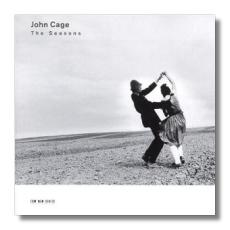
The Internet's Premier Classical Music Source
Related Links
- Cage Reviews
- Latest Reviews
- More Reviews
-
By Composer
-
Collections
DVD & Blu-ray
Books
Concert Reviews
Articles/Interviews
Software
Audio
Search Amazon
Recommended Links
Site News
 CD Review
CD Review
John Cage

The Seasons
- Seventy-Four (two versions)
- The Seasons
- Concerto for Prepared Piano and Chamber Orchestra
- Suite for Toy Piano (original version and orchestral version by Lou Harrison)
Margaret Leng Tan, prepared piano and toy piano
American Composers Orchestra/Dennis Russell Davies
ECM New Series 1696 465140-2 DDD 75:50
John Cage remains a composer more discussed and read about than actually heard. For some reason, listeners tend to assume that his music is too theoretical or too difficult for them to enjoy. Of course this is not true for everyone, but even Arnold Schoenberg elicits more confidence from concert-goers than Cage, who unfortunately remains known by many as the guy who wrote 4'33", which is not "music" at all. Now ECM New Series, a label trusted by modern music aficionados for the watertight solidity and integrity of its productions, has released a Cage CD. In any event, this is a significant occasion for those who admire Cage, but it may be even more significant because of ECM New Series's high profile. If Cage is good enough for executive producer (and ECM's father) Manfred Eicher, then he may be good enough for the tens of thousands of listeners who heeded Eicher's support of Arvo Pärt, Giya Kancheli, Steve Reich, and other composers.
One of the nice things about this CD is its variety. The compositions span a period of 45 years, and there's a concerto, orchestral pieces, and a solo piece for toy piano. The earliest work is The Seasons (1947). Margaret Leng Tan recorded the solo piano version of this work (New Albion NA070CD); now ECM has recorded the orchestral version. This was Cage's first orchestral score, and Lou Harrison and Virgil Thomson assisted him with the orchestration. Cage was influenced by Indian spirituality and aesthetics in this work. Winter represents quiescence, spring represents creation, summer represents preservation, and fall represents destruction. Each season is prefaced by a Prélude. The Seasons, which was commissioned by Lincoln Kirstein for New York City's Ballet Society, is an important work for the composer because he took a large step away from intentionally in the way that he wrote it. Cage called the composition process "considered improvisation," suggesting that the results were neither completely planned nor completely random.
The five-movement, seven-minute Suite for Toy Piano (1948) also was recorded by Tan for the New Albion CD mentioned above. It uses only nine consecutive white keys, so it can be played on even the most rudimentary of toy pianos. (Tan plays a Schoenhut on this CD, but she played a Jaymar on the New Albion CD. Someday, someone's going to do a toy piano comparison.) What Cage does within such drastic self-limitations is interesting, funny, and even a little bit moving. Lou Harrison's orchestration is a characteristic bit of chutzpah, and it makes the music sound even more exotic.
Cage reached a crossroads with his dreamy Concerto for Prepared Piano and Chamber Orchestra (1950-51). In this work, Cage uses both "fixed" and "free" sounds. The former are derived from a chart of pre-determined notes and chords; Cage moves around this chart using an also pre-determined sequence of numbers, or by using the I Ching. The "free" material was composed purely according to the composer's liking at the given moment. The contrast between the fixed and free materials is what gives this concerto its unique sound. Although the work is in the three movements, there is little about this concerto that is traditional, but much that it beautiful, if one can temper one's expectations.
If the concerto is dreamy, Seventy-Four is downright narcoleptic. Written in 1992, this was one of Cage's last pieces. It was commissioned and premièred by the performers who play it on this CD. There are two orchestral parts – one for high instruments and the other for low ones – without any score, per se, and no conductor. Each musician decides when to begin and end, how loudly or softly to play, and whether or not to use expressive devices such as vibrato. Cage actually encourages the different instruments to play "out of tune," relative to each other, thereby creating microtonal discrepancies. Seventy-Four is very slow-moving, and we tend to hear washes of color, not individual notes. It sounds more like a work by Ligeti – Lontano, for example – than something by Cage. There are two versions of the work on this CD, and each is about 12 minutes long. The degree of choice left to the musicians ensures that the two performances are different, and yet they are unmistakably the "same" work. Fascinating.
No complaints about the performances; both Dennis Russell Davies and Margaret Leng Tan were familiar to Cage, and I'm sure they would rather cut off their arms than do violence to his music. If anything is missing, it is up to us, the listener, to supply it. The recording was made in the SUNY Purchase Performing Arts Center, and production and engineering were by the always-excellent Gregory Squires. And for a change, ECM's booklet notes are not just a collection of philosophical obfuscations. A good job all around!
Copyright © 2000, Raymond Tuttle


















